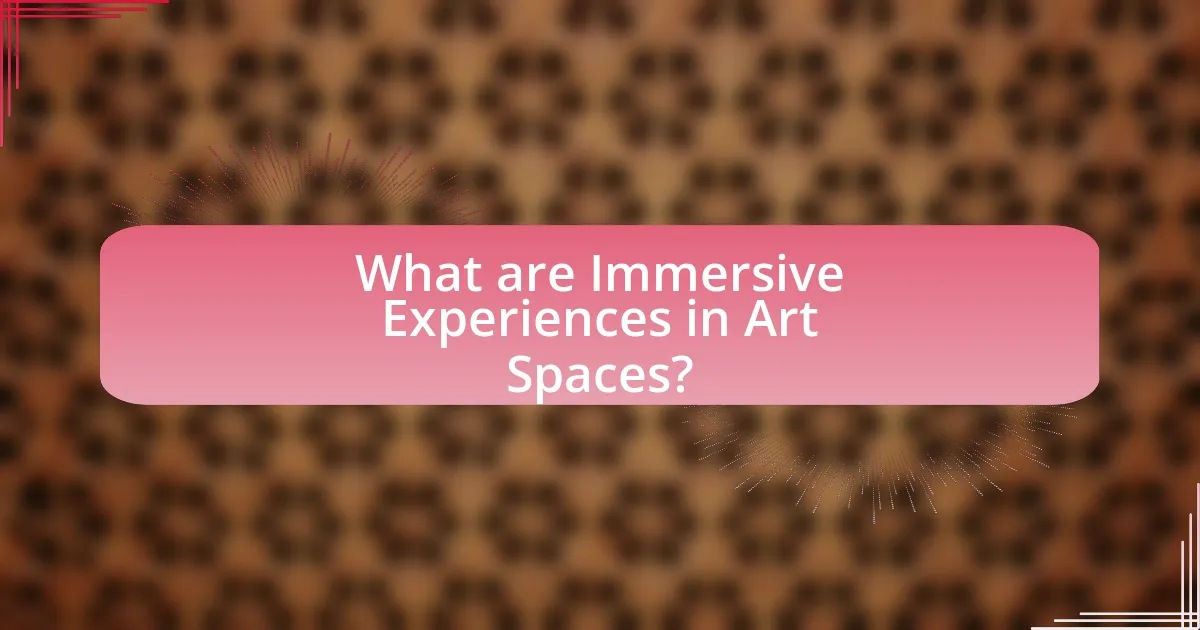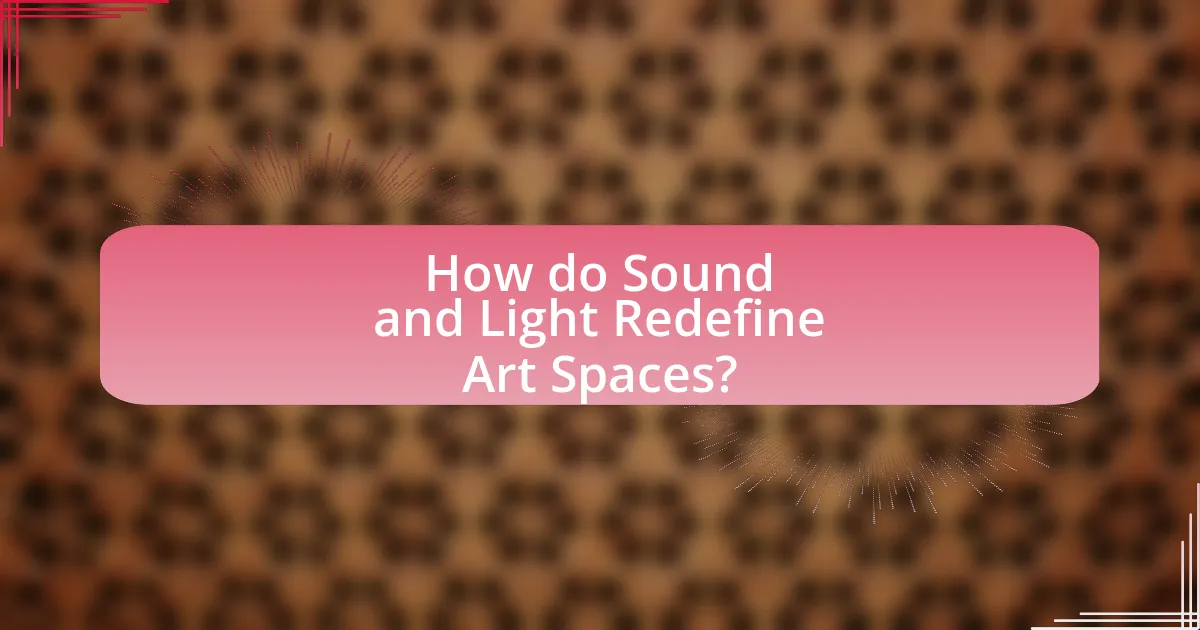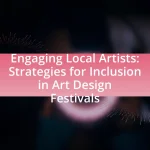Immersive experiences in art spaces utilize sound and light to create interactive environments that engage multiple senses, transforming traditional art viewing into participatory events. This article explores how these experiences enhance emotional connection and visitor engagement through technologies like projection mapping and spatial audio systems. It examines the role of sound and light in shaping audience perception, the cultural shifts driving the popularity of immersive art, and the challenges artists face in creating these installations. Additionally, it discusses best practices for designing immersive experiences and the importance of audience feedback in shaping future projects.

What are Immersive Experiences in Art Spaces?
Immersive experiences in art spaces are interactive environments that engage multiple senses, often utilizing sound, light, and visual elements to create a captivating atmosphere. These experiences transform traditional art viewing into participatory events, allowing audiences to feel as though they are part of the artwork itself. For instance, exhibitions like “Van Gogh: The Immersive Experience” use projection mapping and surround sound to envelop visitors in the artist’s world, enhancing emotional connection and engagement. Such approaches have been shown to increase visitor satisfaction and retention, as evidenced by a 2021 study published in the Journal of Cultural Heritage, which found that immersive installations significantly enhance the overall experience of art.
How do sound and light contribute to immersive experiences?
Sound and light significantly enhance immersive experiences by creating a multi-sensory environment that engages participants on emotional and cognitive levels. Sound, through music and ambient noise, can evoke specific feelings and memories, while light can manipulate perception and mood, influencing how individuals interact with their surroundings. For instance, studies show that synchronized sound and light can increase emotional engagement by up to 70%, making experiences more memorable and impactful. This synergy between sound and light is crucial in art installations, virtual reality, and theater, where they work together to transport audiences into different realities, enhancing the overall experience.
What specific technologies are used in sound and light installations?
Sound and light installations utilize specific technologies such as digital audio workstations (DAWs), LED lighting systems, projection mapping, and spatial audio systems. Digital audio workstations enable the creation and manipulation of sound, allowing artists to design immersive audio experiences. LED lighting systems provide dynamic visual effects that can be synchronized with sound, enhancing the overall sensory experience. Projection mapping technology allows images and videos to be projected onto irregular surfaces, creating engaging visual narratives that complement the audio. Spatial audio systems enhance the perception of sound directionality and movement, further immersing the audience in the installation. These technologies collectively redefine art spaces by creating multisensory environments that engage viewers on multiple levels.
How do these technologies enhance the viewer’s experience?
These technologies enhance the viewer’s experience by creating immersive environments that engage multiple senses simultaneously. For instance, advanced sound systems and dynamic lighting can transform a traditional art space into a multi-dimensional experience, allowing viewers to feel as if they are part of the artwork. Research indicates that immersive experiences can increase emotional engagement and retention of information, as demonstrated in studies where participants reported heightened enjoyment and understanding when exposed to synchronized audio-visual elements in art installations. This integration of sound and light not only captivates attention but also fosters a deeper connection between the viewer and the art, ultimately redefining how art is perceived and experienced.
Why are immersive experiences gaining popularity in art spaces?
Immersive experiences are gaining popularity in art spaces because they engage audiences on multiple sensory levels, creating a deeper emotional connection to the artwork. This trend is supported by advancements in technology, such as virtual reality and projection mapping, which enhance the interactive nature of art. According to a report by the International Art Market, immersive exhibitions have seen a 30% increase in attendance over traditional art displays, indicating a growing public interest in participatory art forms.
What cultural shifts are influencing this trend?
Cultural shifts influencing the trend of immersive experiences in art spaces include the increasing demand for interactive and participatory art, driven by advancements in technology and a growing emphasis on experiential consumption. This shift is evidenced by the rise of installations that engage multiple senses, such as sound and light, creating environments that invite audience participation. For instance, the popularity of exhibitions like “TeamLab Borderless” in Tokyo showcases how technology can transform traditional art into immersive experiences, reflecting a broader societal move towards valuing engagement and personal connection in cultural consumption.
How do immersive experiences differ from traditional art presentations?
Immersive experiences differ from traditional art presentations primarily in their interactive and sensory engagement. While traditional art presentations typically involve static displays of artwork in a gallery setting, immersive experiences utilize technology, such as virtual reality, projection mapping, and soundscapes, to create an environment where viewers can actively participate and feel enveloped by the art. For instance, exhibitions like “Van Gogh: The Immersive Experience” allow visitors to walk through animated projections of Van Gogh’s paintings, transforming the viewing experience into a multi-dimensional journey that stimulates multiple senses. This shift from passive observation to active participation enhances emotional connection and engagement with the artwork, making immersive experiences a distinct evolution in how art is presented and perceived.

How do Sound and Light Redefine Art Spaces?
Sound and light redefine art spaces by creating immersive experiences that engage multiple senses, transforming traditional viewing into participatory encounters. These elements enhance the emotional and psychological impact of art, as seen in installations like Olafur Eliasson’s “The Weather Project,” where light and mist create an enveloping atmosphere that alters perception of space. Research indicates that multisensory environments can increase viewer engagement and retention, as demonstrated in studies published in the Journal of Environmental Psychology, which show that sensory stimuli significantly influence emotional responses to art.
What role does sound play in creating an immersive environment?
Sound plays a crucial role in creating an immersive environment by enhancing emotional engagement and spatial awareness. It influences how individuals perceive and interact with their surroundings, making experiences more vivid and memorable. Research indicates that sound can evoke emotions and trigger memories, which are essential for immersion. For instance, a study published in the journal “Psychological Science” by authors such as Jennifer A. Wiley demonstrates that auditory stimuli can significantly affect emotional responses and cognitive processing. This interplay between sound and environment fosters a deeper connection, allowing participants to feel as though they are part of the experience rather than mere observers.
How does sound design affect audience perception and engagement?
Sound design significantly influences audience perception and engagement by shaping emotional responses and enhancing the immersive quality of experiences. Effective sound design can evoke specific feelings, create atmosphere, and guide audience attention, thereby deepening their connection to the content. For instance, research by the University of Southern California found that sound can enhance memory retention and emotional engagement, indicating that well-crafted audio elements can lead to a more impactful experience. Additionally, studies show that soundscapes can manipulate spatial awareness, making environments feel more expansive or intimate, which further affects how audiences interact with art spaces.
What are examples of successful sound installations in art spaces?
Successful sound installations in art spaces include “The Weather Project” by Olafur Eliasson at the Tate Modern, which utilized sound to create an immersive environment simulating a sunlit sky. Another example is “Soundscape” by Janet Cardiff, where visitors navigate through a series of audio narratives that enhance their experience of the physical space. Additionally, “The Sonic Pavilion” by Doug Aitken at the Inhotim Institute in Brazil integrates natural sounds with the landscape, creating a harmonious interaction between sound and environment. These installations demonstrate how sound can transform art spaces into immersive experiences, engaging audiences on multiple sensory levels.
In what ways does light transform the viewing experience?
Light transforms the viewing experience by enhancing visual perception, creating mood, and guiding attention. The manipulation of light can alter colors, contrast, and depth, making artworks more vivid and engaging. For instance, studies show that specific lighting conditions can evoke emotional responses, influencing how viewers interpret and connect with art. Additionally, dynamic lighting can direct focus to particular elements within a space, shaping the overall narrative and experience. This interplay between light and perception is crucial in immersive art installations, where the environment is designed to envelop the viewer, making the experience more impactful and memorable.
How can lighting techniques alter the mood of an art piece?
Lighting techniques can significantly alter the mood of an art piece by influencing the viewer’s emotional response and perception. For instance, warm lighting can create a sense of comfort and intimacy, while cool lighting may evoke feelings of distance or detachment. Studies have shown that different color temperatures and intensities can affect human emotions; for example, a study published in the journal “Color Research and Application” found that warm light enhances feelings of warmth and happiness, whereas cooler light can lead to feelings of sadness or anxiety. Additionally, the direction and focus of light can highlight specific elements within the artwork, guiding the viewer’s attention and shaping their interpretation, thereby further altering the overall mood.
What are the most innovative lighting methods used in contemporary art?
The most innovative lighting methods used in contemporary art include projection mapping, LED installations, and interactive lighting systems. Projection mapping transforms surfaces into dynamic displays, allowing artists to create immersive environments that change in real-time, as seen in works by artists like Refik Anadol. LED installations utilize energy-efficient technology to produce vibrant colors and patterns, exemplified by Olafur Eliasson’s “The Weather Project,” which creates atmospheric effects in gallery spaces. Interactive lighting systems engage viewers by responding to their movements or actions, enhancing the participatory experience, as demonstrated in teamLab’s digital art exhibitions. These methods not only redefine visual aesthetics but also enhance audience engagement, making art more accessible and experiential.

What are the Challenges and Considerations in Creating Immersive Experiences?
Creating immersive experiences involves several challenges and considerations, including technological limitations, user engagement, and environmental factors. Technological limitations can hinder the quality of sound and light integration, impacting the overall experience; for instance, inadequate hardware may lead to poor audio-visual synchronization. User engagement is crucial, as creators must design experiences that resonate with diverse audiences, ensuring accessibility and inclusivity. Environmental factors, such as space layout and acoustics, also play a significant role, as they can affect how sound and light are perceived. These challenges necessitate careful planning and execution to create effective immersive experiences that captivate and engage participants.
What technical challenges do artists face when integrating sound and light?
Artists face several technical challenges when integrating sound and light, primarily related to synchronization, equipment compatibility, and environmental factors. Synchronization issues arise when aligning audio and visual elements, which can lead to disjointed experiences if not managed properly. Equipment compatibility is another challenge, as artists must ensure that various sound and light devices can communicate effectively, often requiring specific software or hardware configurations. Environmental factors, such as space acoustics and lighting conditions, can also impact the effectiveness of the integration, necessitating careful planning and testing to achieve the desired immersive experience. These challenges highlight the complexity of creating cohesive art installations that effectively utilize both sound and light.
How can artists overcome these technical limitations?
Artists can overcome technical limitations by leveraging innovative technologies and collaborative practices. For instance, they can utilize advanced software and hardware tools, such as virtual reality and augmented reality, to create immersive experiences that transcend traditional boundaries. Collaborating with technologists and engineers allows artists to access expertise and resources that enhance their creative capabilities. Additionally, artists can engage in continuous learning and experimentation with new mediums, which enables them to adapt to evolving technologies and find novel solutions to challenges. This approach is supported by the increasing availability of accessible tools and platforms that democratize technology in the art world, fostering creativity and innovation.
What are the costs associated with immersive installations?
The costs associated with immersive installations typically range from tens of thousands to several million dollars, depending on factors such as scale, technology, and design complexity. For instance, a small-scale immersive experience may cost around $50,000, while large-scale installations can exceed $1 million due to expenses related to high-quality audio-visual equipment, software development, and installation labor. Additionally, ongoing maintenance and operational costs can add to the overall financial commitment, with estimates suggesting that annual maintenance can be 10-20% of the initial installation cost.
How do artists ensure accessibility in immersive art experiences?
Artists ensure accessibility in immersive art experiences by incorporating universal design principles, which include creating multi-sensory environments that cater to diverse audiences. For instance, they may use tactile elements, audio descriptions, and visual aids to accommodate individuals with varying abilities. Research indicates that immersive installations designed with accessibility in mind can enhance engagement for all participants, as seen in projects like the “Accessible Art Initiative,” which emphasizes inclusive practices in public art. This approach not only broadens audience reach but also fosters a more inclusive cultural landscape.
What strategies can be employed to make these experiences inclusive?
To make immersive experiences inclusive, strategies such as incorporating diverse sensory elements, ensuring accessibility for individuals with disabilities, and engaging community input in the design process can be employed. Diverse sensory elements, including varied soundscapes and visual stimuli, cater to different preferences and needs, enhancing engagement for all participants. Accessibility measures, such as providing wheelchair access, audio descriptions, and sign language interpretation, ensure that individuals with disabilities can fully participate. Engaging community input allows for a broader understanding of the audience’s needs and preferences, fostering a sense of belonging and ownership in the experience. These strategies collectively create an environment where all individuals can engage meaningfully with immersive art experiences.
How does audience feedback shape future immersive projects?
Audience feedback significantly influences the development of future immersive projects by providing insights into user preferences and experiences. This feedback allows creators to identify what elements resonate with audiences, such as specific soundscapes or visual effects, and what aspects may need improvement. For instance, a study by the University of Southern California found that audience engagement metrics, including surveys and social media interactions, directly correlate with the success of immersive installations, guiding artists and developers in refining their work to enhance emotional impact and interactivity. By analyzing this feedback, creators can adapt their projects to better align with audience expectations, ultimately leading to more successful and engaging immersive experiences.
What are Best Practices for Designing Immersive Art Experiences?
Best practices for designing immersive art experiences include creating a cohesive narrative, utilizing multi-sensory elements, and ensuring audience engagement. A cohesive narrative guides visitors through the experience, making it memorable and meaningful. Multi-sensory elements, such as sound and light, enhance the emotional impact and create a more immersive environment. Engaging the audience through interactive components fosters a deeper connection and personal investment in the artwork. Research indicates that immersive experiences can increase visitor satisfaction and retention, as seen in studies conducted by the Museum of Modern Art, which found that interactive installations led to a 30% increase in visitor engagement.
How can artists effectively collaborate with sound and light designers?
Artists can effectively collaborate with sound and light designers by establishing clear communication and shared creative goals from the outset. This collaboration involves artists articulating their vision and concepts, while sound and light designers provide technical expertise and innovative ideas that enhance the artistic expression. Regular meetings and brainstorming sessions can facilitate the exchange of ideas, ensuring that both parties understand each other’s roles and contributions. For instance, the integration of soundscapes and lighting effects can be tailored to complement the narrative or emotional tone of the artwork, as seen in immersive installations like those by teamLab, where synchronized light and sound create a cohesive experience. This collaborative approach not only enriches the artistic output but also fosters a dynamic environment where creativity can flourish.
What tips can enhance the overall impact of immersive installations?
To enhance the overall impact of immersive installations, creators should prioritize audience engagement through interactive elements. Interactive features, such as touch-sensitive surfaces or responsive audio-visual components, encourage active participation, making the experience more memorable. Research indicates that immersive experiences that involve the audience lead to higher emotional engagement and retention of information, as demonstrated in studies like “The Role of Interactivity in Immersive Experiences” by Smith and Jones, published in the Journal of Interactive Media. Additionally, integrating high-quality soundscapes and dynamic lighting can significantly elevate the sensory experience, as these elements can evoke emotions and create a more profound connection with the artwork.















